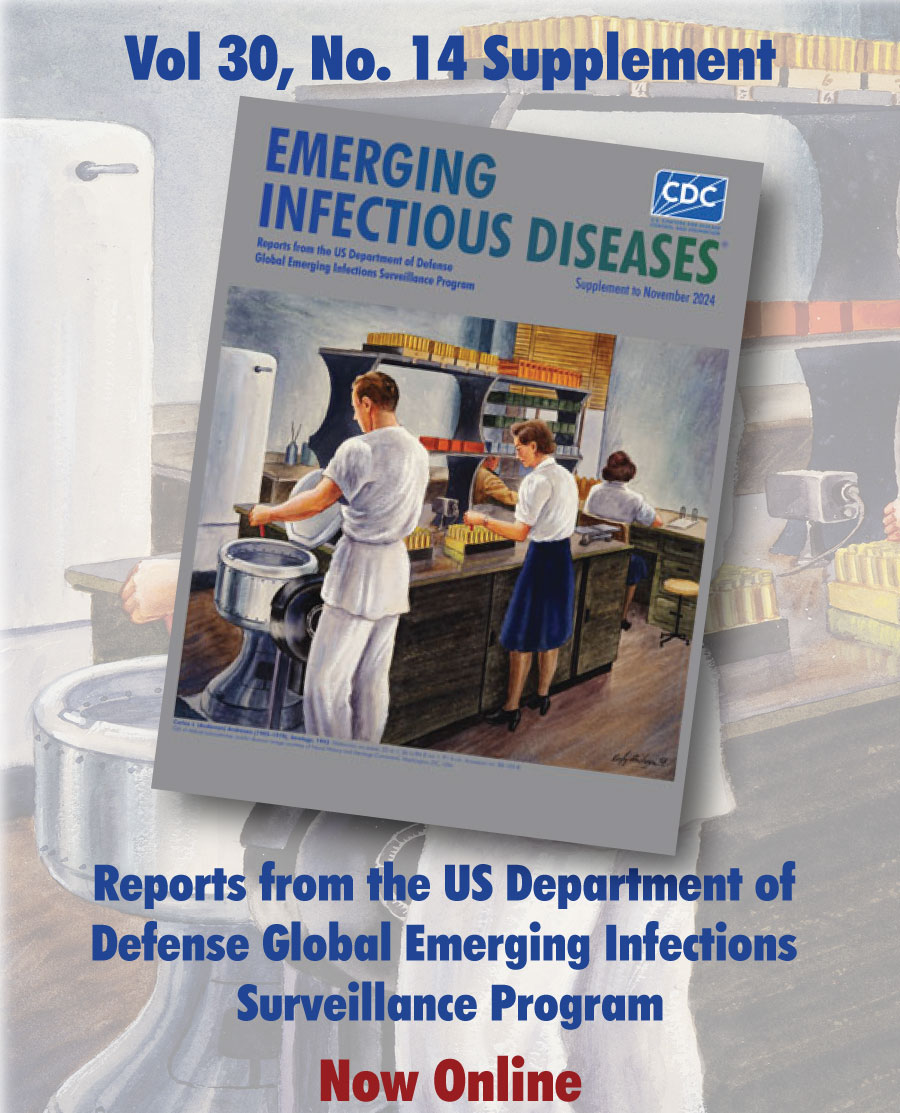Early Release
Disclaimer: Early release articles are not considered as final versions. Any changes will be reflected in the online version in the month the article is officially released.
Volume 31, Number 6—June 2025
Synopses
- Clinical Manifestations, Risk Factors, and Disease Burden of Rickettsiosis, Cambodia, 2007–2020
- Multicenter Retrospective Study of Spiroplasma ixodetis Infantile Cataract in 8 Countries in Europe
Research
- Long-Term Clinical Outcomes of Adults Hospitalized for COVID-19 Pneumonia
- Prospective Multicenter Surveillance of Helicobacter pylori and Non–H. pylori Helicobacter Infections during Medical Checkups, Japan, 2022
-
Safety and Immunogenicity of Poultry Vaccine for Protecting Critically Endangered Avian Species against Highly Pathogenic Avian Influenza Virus, United States
In 2023, an outbreak of highly pathogenic avian influenza occurred among critically endangered California condors (Gymnogyps californianus), and >21 died. We evaluated safety, immunogenicity, vaccination strategies, and correlates of antibody response of an influenza vaccine for poultry in black vultures (Coragyps atratus) and then California condors. We noted differences in antibody titers between vaccinated and unvaccinated birds (vultures p<0.004; condors p<0.02) but no adverse effects of vaccination. All vaccinated vultures and 80% of vaccinated condors showed maximum measured antibody response within the published range associated with survival of vaccinated and virally challenged chickens. We noted weak evidence of higher antibody responses for birds given two 0.5-mL vaccines versus those given one 1-mL vaccine but no correlation between antibody titers and sex for either species or between antibody titers and bone lead concentrations in vultures. Our results prompted initiation of a vaccination program for condors that could reduce spread of this disease among highly threatened species.
- Diagnostic Accuracy of 3 Mpox Lateral Flow Assays for Antigen Detection, Democratic Republic of the Congo and United Kingdom
- Characterization of Adult and Pediatric Healthcare-Associated and Community-Associated Clostridioides difficile Infections, Canada, 2015–2022
- Force of Infection Model for Estimating Time to Dengue Virus Seropositivity among Expatriate Populations, Thailand
- Genesis and Spread of Novel Highly Pathogenic Avian Influenza A(H5N1) Clade 2.3.4.4b Virus Genotype EA-2023-DG Reassortant, Western Europe
Dispatches
- Negligible Neutralization of Influenza A(H5N1) Virus by Quadrivalent Seasonal Vaccines, United Kingdom, 2021–2024
- Mycoplasma arginini Cellulitis, Tenosynovitis, and Arthritis in a Kidney Transplant Recipient, Slovenia, 2024
- Cadaveric Human Growth Hormone–Associated Creutzfeldt-Jakob Disease with Long Latency Period, United States
- Use of Oral Flea Preventative to Control Rickettsia typhi–Infected Fleas on Reservoir Opossums, Galveston, Texas, USA, 2023–2024
- Global Prevalence of Nitroimidazole-Refractory Giardiasis, 2008–2020
- Three Cases of Human Babesiosis, Italy, 2017–2020
- Characterization of OXA-204 Carbapenemase in a Clinical Isolate of Pseudomonas guariconensis
- High Prevalence of Artemisinin-Resistant Plasmodium falciparum Kelch13 R622i and Hrp2/3 Deleted Parasites in South-Eastern Sudan
Research Letters
- Baylisascaris procyonis Roundworm in Common Raccoons, Mexico
- Highly pathogenic avian influenza A(H5N1) clade 2.3.4.4b virus isolated from a dairy farm worker in Michigan transmits through the air in a ferret model
- Nosocomial Transmission of Plasmodium falciparum Malaria, Spain, 2024
- Molecular Detection of Wesselsbron Virus in Dromedary Camel, Borana Zone, Ethiopia, 2024
- Aedes aegypti Mosquito Detection at Bus Stations, Bogota, Colombia, 2023–2024
Volume 31, Supplement—May 2025
- SARS-CoV-2 Genomic Surveillance from Community-Distributed Rapid Antigen Tests, Wisconsin, USA
-
Leveraging a Strategic Public–Private Partnership to Launch an Airport-Based Pathogen Monitoring Program to Detect Emerging Health Threats
Airport-based pathogen monitoring is a critical tool that can contribute to early detection and characterization of existing and new pathogen threats. A novel public–private partnership between an airport spa group, a biotech company, and the Centers for Disease Control and Prevention was instrumental in establishing a multimodal pathogen genomic surveillance program at US international airports. That public–private partnership addressed critical challenges that neither party could overcome independently, resulting in the development and deployment of a scalable, flexible early warning system for pathogen detection and public health monitoring.
- Genomic Epidemiology and Phylodynamic Modelling of an Outbreak of Multidrug Resistant Shigella sonnei, San Francisco Bay Area, California, USA, 2023–2024
- Genomic Characterization of Escherichia coli O157:H7 Associated with Multiple Sources, United States
- Large-Scale Genomic Analysis of SARS-CoV-2 Omicron BA.5 Emergence, United States
-
Establishing Methods to Monitor Influenza (A)H5N1 Virus in Dairy Cattle Milk, Massachusetts, USA
Highly pathogenic avian influenza A(H5N1) virus has caused a multistate outbreak among US dairy cattle, spreading across 16 states and infecting hundreds of herds since its onset. We rapidly developed and optimized PCR-based detection assays and sequencing protocols to support H5N1 molecular surveillance. Using 214 retail milk samples from 20 states for methods development, we found that H5N1 virus concentrations by digital PCR strongly correlated with quantitative PCR cycle threshold values; digital PCR exhibited greater sensitivity. Metagenomic sequencing after hybrid selection was best for higher concentration samples, whereas amplicon sequencing performed best for lower concentrations. By establishing these methods, we were able to support the creation of a statewide surveillance program to perform monthly testing of bulk milk samples from all dairy cattle farms in Massachusetts, USA, which remain negative to date. The methods, workflow, and recommendations described provide a framework for others aiming to conduct H5N1 surveillance efforts.
- Advanced Molecular Detection Improves Public Health Response to Infectious Diseases
- Effects of Decentralized Sequencing on National Listeria monocytogenes Genomic Surveillance, Australia, 2016–2023
-
Strategies and Opportunities to Improve Community Health through Advanced Molecular Detection and Genomic Surveillance of Infectious Diseases
Advanced molecular detection (AMD) refers to the integration of next-generation sequencing, epidemiologic, and bioinformatics data to drive public health actions. As new AMD technologies emerge, it is critical to ensure those methods are used in communities that are most affected by disease-induced illness and death. We describe strategies and opportunities for using AMD approaches to improve health in those communities, which include improving access to pathogen sequencing, increasing data linkages, and using pathogen sequencing for those diseases where sequencing technologies can provide the best health outcome. Such strategies can help address and prevent differences in health outcomes in various populations, such as rural and tribal communities, persons with underlying health issues, and other populations that experience higher risks for infectious disease.
- Lessons from 5 Years of Routine Whole-Genome Sequencing for Epidemiologic Surveillance of Shiga Toxin–Producing Escherichia coli, France, 2018–2022
- Nationwide Implementation of HIV Molecular Cluster Detection by Centers for Disease Control and Prevention and State and Local Health Departments, United States
-
Genomic Epidemiology for Estimating Pathogen Burden in a Population
The role of genomics in outbreak response and pathogen surveillance has expanded and ushered in the age of pathogen intelligence. Genomic surveillance enables detection and monitoring of novel pathogens; case clusters; and markers of virulence, antimicrobial resistance, and immune escape. We can leverage pathogen genomic diversity to estimate total pathogen burden in populations and environments, which was previously challenging because of unreliable data. Pathogen genomics might allow pathogen burdens to be estimated by sequencing even a small percentage of cases. Deeper genomic epidemiology analyses require multidisciplinary collaboration to ensure accurate and actionable real-time pathogen intelligence.
- 16S Ribosomal RNA Gene PCR and Sequencing of Normally Sterile Body Fluids and Tissues for Pediatric Infection Diagnosis, United States, 2020-2023
-
Successful Transition to Whole-Genome Sequencing and Bioinformatics to Identify Invasive Streptococcus spp. Drug Resistance, Alaska, USA
The Centers for Disease Control and Prevention’s Arctic Investigations Program evaluated whole-genome sequencing (WGS) workflows and bioinformatics pipelines developed by the Centers’ Streptococcus Laboratory. We compared WGS-based antimicrobial drug resistance predictions with phenotypic testing for group B (n = 130) and group A (n = 217) Streptococcus and Streptococcus pneumoniae (n = 293). Isolates were collected in Alaska during January 2019–February 2021. We also included a historical phenotypically nonsusceptible subset. Concordances between phenotypic testing and WGS predictions were 99.9% (895/896) for group B Streptococcus, 100% (1,298/1,298) for group A Streptococcus, and 99.98% (3,516/3,517) for S. pneumoniae. Common resistance determinants were ermTR, ermB, and mef for macrolides, tetM for tetracyclines, and gyrA and parC for levofloxacin. S. pneumoniae trimethoprim/sulfamethoxazole nonsusceptibility was associated with folP gene insertions and folA mutations. In 2022, the Arctic Investigations Program transitioned Streptococcus spp. workflows to WGS, enabling more rapid monitoring and prevention of invasive disease.
-
Real-Time Use of Monkeypox Virus Genomic Surveillance, King County, Washington, USA, 2022–2024
A monkeypox virus genomic surveillance pilot began in King County, Washington, USA, during the 2022 outbreak. Genomic surveillance proved critical in determining local versus international exposure of a case where no known exposures were identified by interview, illustrating the value of genomics in case investigation and public health practice.
- Detection and Tracking of SARS-CoV-2 Lineages through National Wastewater Surveillance System Pathogen Genomics
-
Respiratory Virus Detection and Sequencing from SARS-CoV-2–Negative Rapid Antigen Tests
Genomic epidemiology offers insight into the transmission and evolution of respiratory viruses. We used metagenomic sequencing from negative SARS-CoV-2 rapid antigen tests to identify a wide range of respiratory viruses and generate full genome sequences. This process offers a streamlined mechanism for broad respiratory virus genomic surveillance.
-
The Next-Generation Sequencing Quality Initiative and Challenges in Clinical and Public Health Laboratories
The Next-Generation Sequencing (NGS) Quality Initiative addresses laboratory challenges faced when performing NGS by developing tools and resources to build a robust quality management system. Here, we illustrate how those products support laboratories in navigating complex regulatory environments and quality-related challenges while implementing NGS effectively in an evolving landscape.
- A Decade of Partnerships and Progress in Pathogen Genomics in Public Health Practice
-
Advantages of Software Containerization in Public Health Infectious Disease Genomic Surveillance
Bioinformatic software containerization, the process of packaging software that encapsulates an application together with all necessary dependencies to simplify installation and use, has improved the deployment and management of next-generation sequencing workflows in both clinical and public health laboratories. Containers have increased next-generation sequencing workflow reproducibility and broadened their usage across different laboratories. We highlight the value of the State Public Health Bioinformatics community’s containerized software repository during the COVID-19 pandemic.
-
Integrating Genomic Data into Public Health Surveillance for Multidrug-Resistant Organisms, Washington, USA
Mitigating antimicrobial resistance (AMR) is a public health priority to preserve antimicrobial treatment options. The Washington State Department of Health in Washington, USA, piloted a process to leverage longitudinal genomic surveillance on the basis of whole-genome sequencing (WGS) and a genomics-first cluster definition to enhance AMR surveillance. Here, we outline the approach to collaborative surveillance and describe the pilot using 6 carbapenemase-producing organism outbreaks of 3 species: Pseudomonas aeruginosa, Acinetobacter baumannii, and Klebsiella pneumoniae. We also highlight how we applied the approach to an emerging outbreak. We found that genomic and epidemiologic data define highly congruent outbreaks. By layering genomic and epidemiologic data, we refined linkage hypotheses and addressed gaps in traditional epidemiologic surveillance. With the accessibility of WGS, public health agencies must leverage new approaches to modernize surveillance for communicable diseases.
Volume 31, Number 7—July 2025
Research Letter
- Fatal Acute Hypoxemic Respiratory Failure Caused by Burkholderia thailandensis, People’s Republic of China




